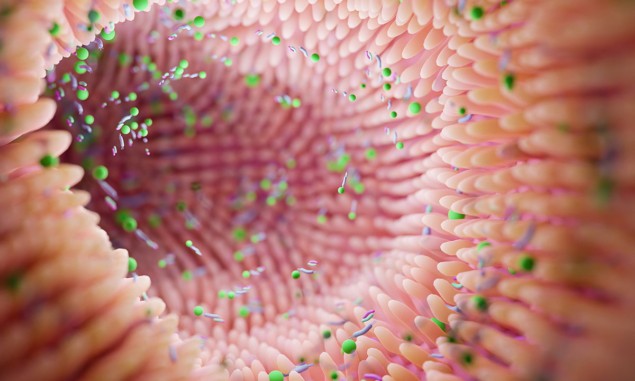Simulations shed light on fluid dynamics of the gut
14 Oct 2022
Balance the flow: Simulations reveal that the gut alternates between different patterns of contraction to optimize nutrient absorption while regulating the growth of bacteria inside the gut. (Courtesy: iStock/Oleksandra-Troian)
To maintain a healthy balance between nutrient absorption and bacteria populations, the human gut likely alternates between two distinct patterns of muscle contraction, according to a study by researchers in Germany and the US. Through simulations, a team led by Karen Alim at the Technical University of Munich showed that these patterns are intrinsically linked to the speed of fluid flowing through the gut.
The ways in which our digestive systems absorb nutrients are heavily influenced by muscle contractions in our intestines. This can happen through two possible ways: in peristalsis, muscles surrounding the small intestine radially contract and relax. These contractions propagate as a wave, driving fast flows of digested food along the tube. Weaker transport is driven by segmentation – where muscles on the inner walls of the intestine contract and relax in a pattern resembling a rippling checkerboard.
Another crucial factor behind nutrient absorption in the gut are the vast numbers of bacteria living inside the intestines, together known as the “microbiota”. These microbes compete with the gut as they absorb nutrients, and play a crucial role in the functioning and general health of the gut – but can also trigger dangerous side-effects if their density becomes too high.
Each of these three phenomena has been studied independently in some detail – but so far, researchers haven’t yet considered how they may be connected. To answer this question, Alim’s team modelled the small intestine as a hollow, deformable cylinder with a nutrient-laden fluid flowing through. They then used fluid dynamics simulations to examine the differences between flow speeds generated by peristalsis and segmentation, allowing them to monitor the resulting effects on populations of bacteria flowing through the gut.
The model showed that the slower flow speeds associated with segmentation caused nutrients to remain in the gut for longer. This would allow the body to absorb nutrients more efficiently, by mixing unevenly spread nutrients into more uniform concentrations. Simultaneously, it would allow the microbiota to grow larger before being flushed out of the gut. In contrast, peristalsis hastened flow speeds through the gut – leading to lower levels of nutrient absorption, while flushing out bacteria at a faster rate.READ MORE

From their results, Alim’s team suggest that the gut alternates between the two patterns of contraction to optimize the efficiency of nutrient absorption, while regulating the growth of microbiota. Their discovery offers a new understanding of the complex dynamics that link the microbiota to muscle contractions in the gut, and also provides important insight into how our digestive systems operate. By drawing from these results, researchers could develop new ways to diagnose and treat gut-related diseases.
The team describe the study in Physical Review Letters.
Sam Jarman is a science writer based in the UK.
From physicsworld.com 15/11/2022

Δεν υπάρχουν σχόλια:
Δημοσίευση σχολίου